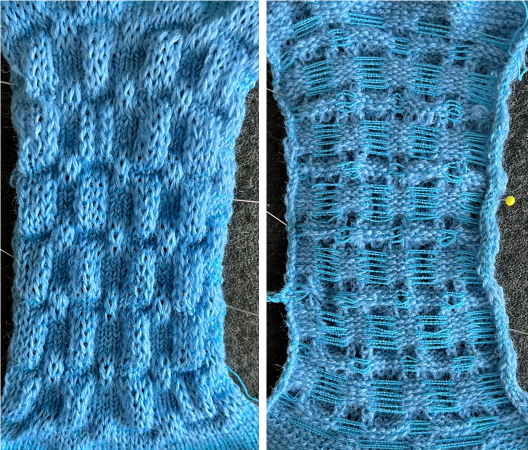Blistered stitches DBJ began to explore some variations for the production of easy knits which resulted in pockets separated by areas of joined stitches, and depending on the design and whether one bed knits more stitches and rows than the other, can make the surface appear 3D to varying degrees.
There are several things to consider in DIY designs.
In my recent browsing and being inspired by “The curse of truchet tiles”, this png was one of the resulting repeats, developed using ArahPaint. It is larger than any previously tested with this technique.
Beginning with a 36X36 file ![]() drawn in test alignment to 108X108,
drawn in test alignment to 108X108, 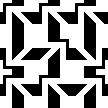 expanding the design through a diagonal choice
expanding the design through a diagonal choice 
![]() into a 72X36 repeat
into a 72X36 repeat ![]()
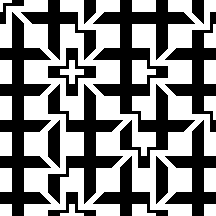 Large repeats require large swatches if gauge matters, but smaller tests serve well to evaluate tension and cam settings. It is a good idea to be consistent in yarn choice.
Large repeats require large swatches if gauge matters, but smaller tests serve well to evaluate tension and cam settings. It is a good idea to be consistent in yarn choice.
Thinking things through:
the white pixel areas will produce the pockets, separating from the ground, and the black pixel areas will compose the joined portions of knit.
To increase the effect, the height of those black pixel areas is reduced by changing their configuration in order to use the slip stitch setting to shorten them.
The first pattern fill requires doubling the height of the whole repeat in order to use the file in a tubular setting. ![]()
 Rather than doubling the file in height, this brush is used to fill the same black pixel areas.
Rather than doubling the file in height, this brush is used to fill the same black pixel areas. 
![]() After a few pixel cleanups, this is the final repeat,
After a few pixel cleanups, this is the final repeat, ![]()
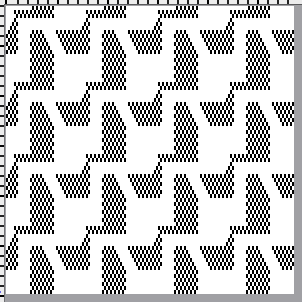 The png was tiled to the number of stitches planned, with the addition of a knit stitch border along each vertical side
The png was tiled to the number of stitches planned, with the addition of a knit stitch border along each vertical side ![]() and knit on 88 stitches for proof of concept.
and knit on 88 stitches for proof of concept.
End needle selection is on.
The carriages are set to slip in opposite directions, in either arrangement A or B.  In one-color knitting starting preselection side does not matter.
In one-color knitting starting preselection side does not matter.
The tension used, since so many stitches will be knitting on alternate beds, needs to approach that used for the same yarn when knitting stocking stitches.
The red yarn stitches mark the knit side of the fabric.
The cotton ball illustrates the formation of pockets.
The color change happened when the first cone of yarn ran out.
The yarns are 2/28 Italian imports of nonspecified fiber content.
The piece measures 10.5 inches in width.
When the settings are changed from tubular to every needle rib, the fabric is considerably wider and ruffles as seen at the top and bottom of the swatch, which could become a planned design feature. 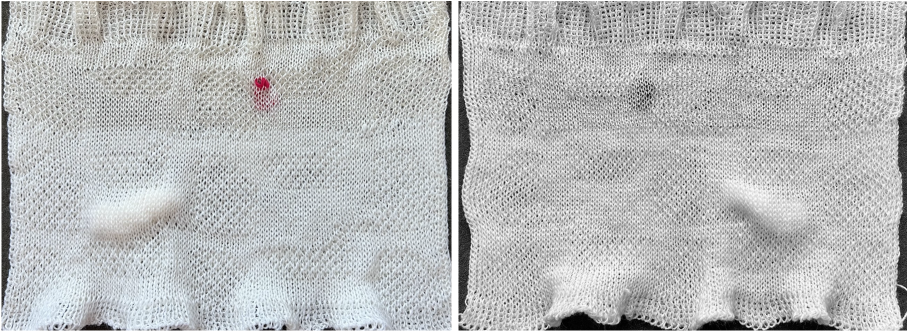 A segment was cropped from the 72X36 drawn once more in repeat to 84X72, repeating the same steps for processing the file
A segment was cropped from the 72X36 drawn once more in repeat to 84X72, repeating the same steps for processing the file 

 alignment check
alignment check 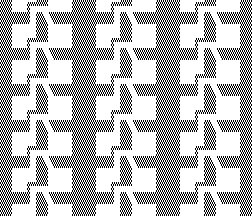 If the plan is to evaluate the effect of tuck stitch on the design, to begin with, the file needs to be color reversed, whether in the drawn png or using machine settings
If the plan is to evaluate the effect of tuck stitch on the design, to begin with, the file needs to be color reversed, whether in the drawn png or using machine settings  Exploring results with the ribber set to knit in on every row, the swatch below the red line was produced with the knit carriage set to knit in one direction, tuck in the other, while in the remainder the knit carriage set to tuck in both directions. The areas that in slip stitch would form pockets knit in every needle rib, while tuck stitch segments produce a lacy effect.
Exploring results with the ribber set to knit in on every row, the swatch below the red line was produced with the knit carriage set to knit in one direction, tuck in the other, while in the remainder the knit carriage set to tuck in both directions. The areas that in slip stitch would form pockets knit in every needle rib, while tuck stitch segments produce a lacy effect. 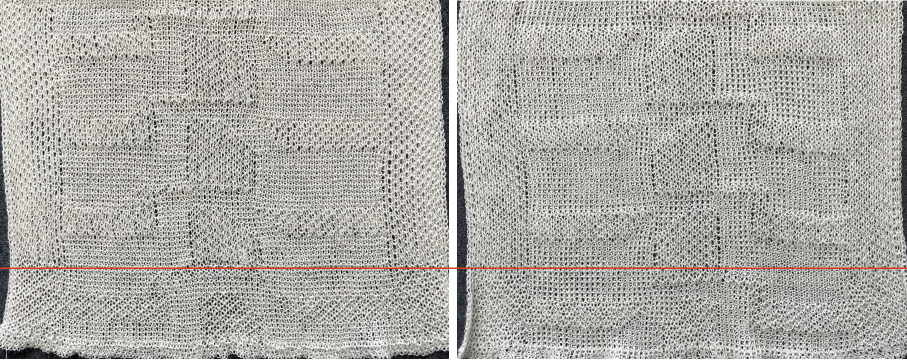 The same design, using the png created prior to color reverse, set for tubular slip stitch
The same design, using the png created prior to color reverse, set for tubular slip stitch  the transition between the changes in knit carriage cam settings results in changes in textures and added width
the transition between the changes in knit carriage cam settings results in changes in textures and added width  The full tuck section (bottom) measures 16 inches in width, and the slip-stitch one (top) measures 11.5 inches.
The full tuck section (bottom) measures 16 inches in width, and the slip-stitch one (top) measures 11.5 inches.
Trying for a half-cardigan repeat with the same yarn produced an extremely wide knit with no discernible design.
Tired of double-bed knitting and swatches in a single color and large enough to cover pillows? the starting image reduced in size X4 to 21X18 pixels opens a new series of opportunities for knitting including on the single bed. 
![]() The design, knit here as DBJ, uses the built-in KRC color separation. At the bottom, the knit carriage is set to slip in both directions. The ribber uses the birdseye setting in both directions with the addition of lili buttons.
The design, knit here as DBJ, uses the built-in KRC color separation. At the bottom, the knit carriage is set to slip in both directions. The ribber uses the birdseye setting in both directions with the addition of lili buttons.
At the top, the knit carriage setting remains unchanged, and the ribber is set to knit in both directions, for a striper backing. The tension remained unchanged. The image illustrates the difference in the aspect ratio of the design and the height and width produced by the respective settings. 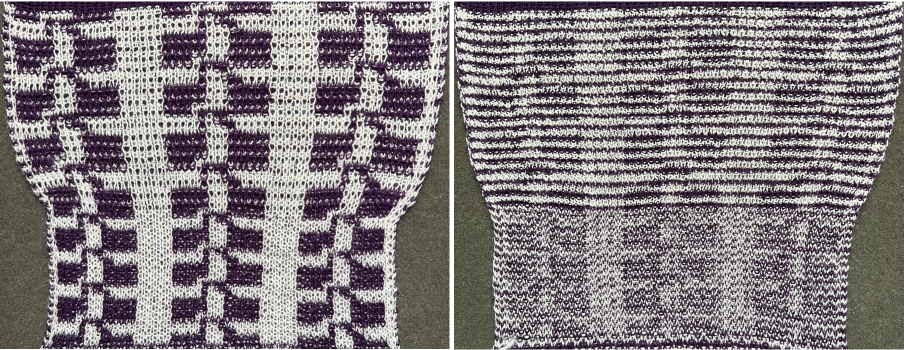 The same design knit as single bed fair isle produces problematic floats on the reverse which would need to be anchored down in a wearable.
The same design knit as single bed fair isle produces problematic floats on the reverse which would need to be anchored down in a wearable. 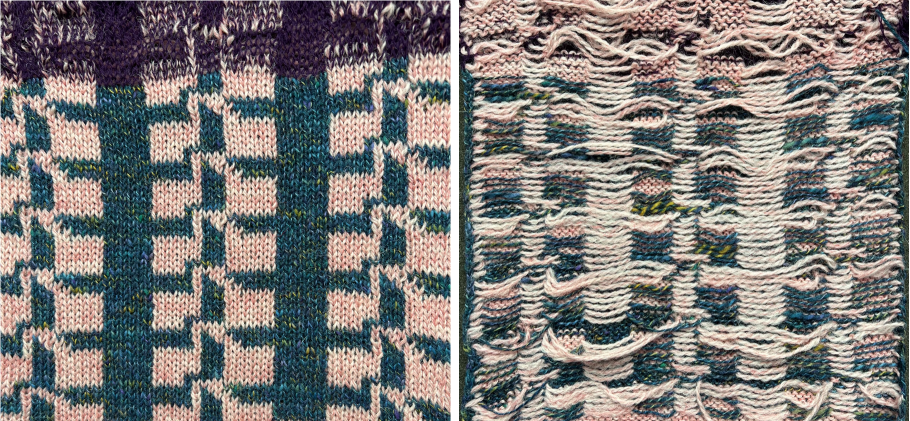 When knitting fair isle end needle selection is used to keep the yarn in the B feeder anchored so as to prevent any separations along the vertical edges of the design.
When knitting fair isle end needle selection is used to keep the yarn in the B feeder anchored so as to prevent any separations along the vertical edges of the design.
Here the light color is 2/8 wool. The yarn in the B feeder is switched to a 2/24 random contrasting color, and the knit carriage is set for thread lace. The white pixels knit both yarns together. Programming a blank row and knitting 2 yarns in this manner is considered by some an alternative to using the plaiting feeder.
End needle selection is canceled. If needles are brought forward, push at least one back to B so the combined yarns knit. In a long piece, a repeat in the width of the planned number of stitches could be planned with one or two blank pixel borders on vertical sides.
Due to the contrast in yarn thickness, the thin yarn creates large stitches that bulge in areas where it knits with the thicker yarn floating behind it, and the areas with combined yarns recede.
The areas in double thickness secure the yarn that produces floats, so that the latter may be trimmed on the purl side, leaving cut ends in any length. When cutting floats, consider sliding something under them and the thin knit so as to avoid cutting it as well, the fabric will release and flatten. 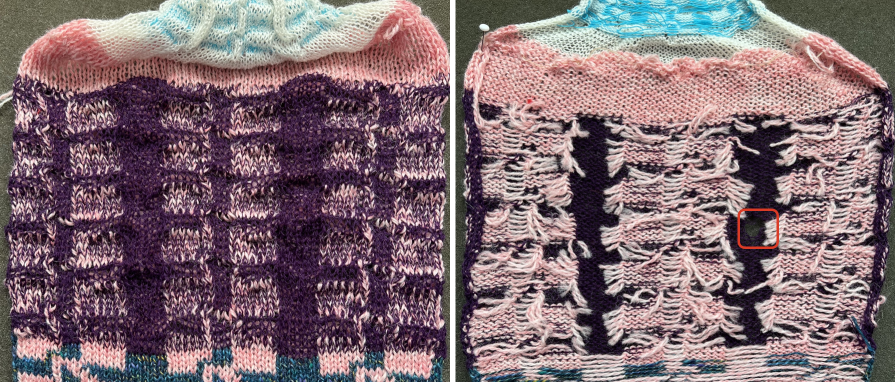 Using elastic, the background yarn used needs to be thinner, here a 2/20. The repeat program is left unchanged, but the position of the yarns is swapped so the elastic/ “thin” is placed in feeder A and the white/ “thick” in feeder B. There is a considerable change in size, observable at the top of the previous images.
Using elastic, the background yarn used needs to be thinner, here a 2/20. The repeat program is left unchanged, but the position of the yarns is swapped so the elastic/ “thin” is placed in feeder A and the white/ “thick” in feeder B. There is a considerable change in size, observable at the top of the previous images.  Aiming for float control, the repeat is edited.
Aiming for float control, the repeat is edited. 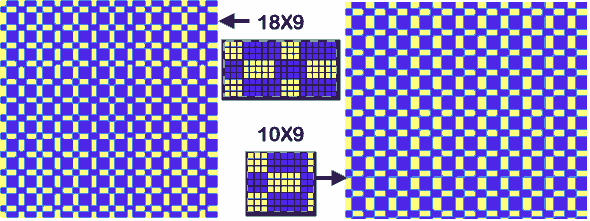 A test of the 18X9 repeat using the fair isle setting measures 6.5 inches in width,
A test of the 18X9 repeat using the fair isle setting measures 6.5 inches in width, 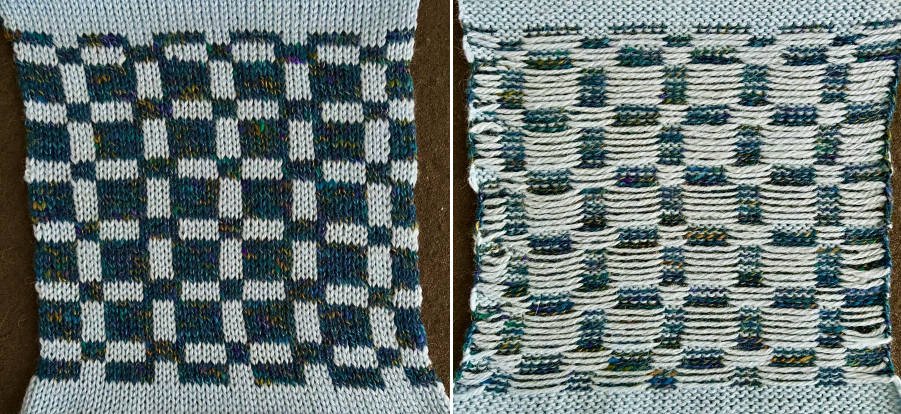 while the same stitch repeat knit using elastic and the thread lace setting adjustments once more, measures just under 2.5 inches in width
while the same stitch repeat knit using elastic and the thread lace setting adjustments once more, measures just under 2.5 inches in width 